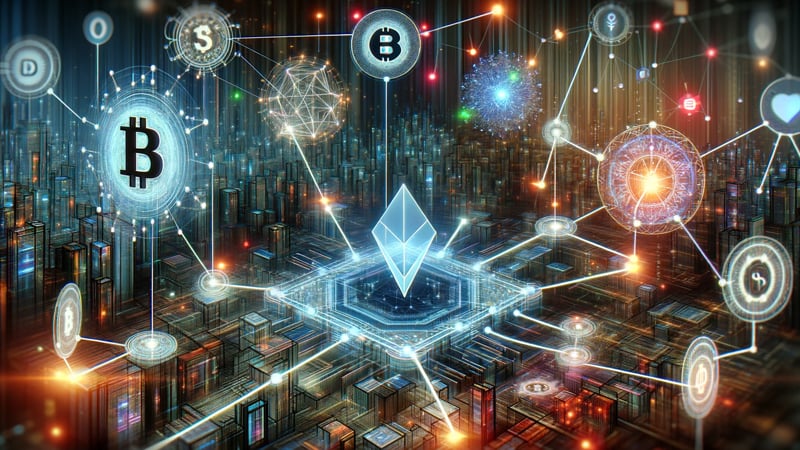Automated Market Makers (AMMs) are revolutionizing the financial sector, especially in the area of decentralized finance (DeFi). AMMs are smart contracts that act as market makers, simplifying trading and providing liquidity to cryptocurrency markets without intermediaries. They facilitate the exchange of digital assets, eliminating the need for a traditional order book to match buyers and sellers.
At the heart of AMMs are liquidity reserves, which are pools of cryptocurrencies, created and managed by the users themselves. Liquidity providers deposit their assets into these pools and receive a percentage of the trading fees generated when others trade with the pool. The mathematical formula implemented in the AMM determines asset prices and ensures that, regardless of demand, there will always be liquidity available to trade.
AMMs are becoming increasingly popular thanks to their benefits such as eliminating intermediaries, democratizing financial market access, and the ability to earn trading fees as a liquidity provider. However, there are also risks, such as the possible loss of capital due to sudden market movements and the so-called “impermanent loss”. It is essential to understand how AMMs work and the potential rewards and risks before participating.
What is AMM in cryptocurrencies?
An Automated Market Maker (AMM) represents a decentralized exchange (DEX) protocol that enables users to buy and sell digital assets without the need for a third-party intermediary. AMMs automate the process of pricing and order matching on the exchange, typically using an algorithm to determine the prices at which buyers and sellers can trade assets. This means that users can acquire and sell crypto assets in a reliable, peer-to-peer manner without relying on a custodian or other third party.
AMMs are recognized for their simplicity, ease of use, and low fees. Traders can quickly open and close positions without worrying about order types, order matching, or other complexities associated with traditional exchanges. Additionally, AMM exchanges are generally faster and more secure than their centralized counterparts as they are powered by smart contracts and secured by the underlying blockchain network.
AMM systems gained momentum after their initial implementation by Shearson Lehman Brothers and ATD in the early 90s. Before their invention, Order Books were created manually by humans who initiated trades with the aim of increasing market liquidity. This method was responsible for some delay and inaccuracy in price discovery in the markets. Furthermore, market makers were also accused of market manipulation. AMMs have solved all the problems caused by human market makers.
AMM vs Order Book
In the blockchain sector, the main distinction between an Automated Market Maker (AMM) and an Order Book lies in the way prices are established. An AMM operates as a liquidity reserve, where prices are automatically determined based on the volume of liquidity present in that reserve. In contrast, the Order Book promotes price discovery through the direct interaction of buyers and sellers, who set their own prices.
In an AMM system, manual price configuration is unnecessary, as the liquidity reserve itself takes care of this task automatically. On the other hand, in Order Book, market participants are responsible for manually setting prices and creating buy and sell orders. Additionally, generally an AMM offers significantly lower fees and better liquidity compared to the Order Book.
Advantages and Disadvantages of AMMs in DeFi
Benefits
- The Automated Market Maker (AMM) model presents a more efficient alternative to traditional order book-based exchange systems, allowing users to trade digital assets without the need for intermediaries.
- AMM liquidity pools make it possible to carry out trades without requiring counterparties.
- AMMs have a high degree of automation, which eliminates users' concerns about manually managing order books.
- AMMs offer low fees to traders as system costs are minimal.
- AMMs provide more liquidity than traditional exchanges, which can be advantageous for traders.
Disadvantages
- AMMs are subject to price slippage and impermanent losses, which can cause significant losses for traders.
- Generally, AMMs are limited to trading only a few assets, meaning traders may not have access to the full range of markets available on traditional exchanges.
- Due to their automated nature, AMMs can be vulnerable to exploitation by malicious actors.
- AMMs can be complex to use, and users may not fully understand how they work.
- AMMs are still relatively new, which implies a risk of bugs or glitches in their code.
- AMMs are not always regulated, which means users may not be protected in the event of a hack or scam.
Automated Market Maker (AMM): Meaning and Definition
Automated Market Maker (AMM) is an algorithm that allows the creation of decentralized financial markets, facilitating the exchange of tokens and the creation of liquidity in so-called Decentralized Exchanges (DEXs). An AMM operates through smart contracts and sets the exchange rate of currencies using the market price in an automated way.
Liquidity providers are participants who contribute to AMMs by adding different tokens to liquidity pools. When an investor makes a trade, the tokens in the pool are exchanged based on the AMM calculation algorithm, which guarantees stable and fair prices for each transaction.
The most commonly used algorithm in AMMs is the Constant Product Formula, which helps determine the price ratio between tokens in liquidity pools. This formula guarantees the main characteristic of AMM, which is finding a balance between supply and demand, ensuring that the total number of tokens in a pool remains constant before and after a transaction is made.
Smart contracts act as intermediaries in the process and guarantee the safe and agile execution of negotiations. Additionally, in an AMM, liquidity providers receive interest rates on tokens, calculated based on the proportion of liquidity they have provided to the pool.
On the other hand, price slippage can occur in an AMM, which means that the difference between the expected price and the price executed in the trade can be significant, especially when dealing with large trading volumes. This phenomenon occurs due to differences between supply and demand rates in the market.
In short, Automated Market Makers represent an innovative solution in the world of decentralized exchanges, providing greater autonomy to investors and creating opportunities for liquidity providers to diversify their investments and obtain remuneration for their active participation in the token market.
FAQ
How does the AMM mechanism work?
The Automated Market Maker (AMM) mechanism works through a smart contract that allows automated trading of cryptocurrencies, without the need for an intermediary in the market. Users provide liquidity to cryptocurrency pools, being rewarded with trading fees, while the contract automatically manages buy and sell orders, balancing prices through specific mathematical functions called pricing functions.
How important is Chainlink in AMM?
Chainlink is a decentralized oracle protocol that provides reliable and secure data to smart contracts. The importance of Chainlink in the AMM mechanism is based on the need for accurate and updated data regarding exchange rates and prices of the cryptocurrencies used. This way, AMM can simplify trading and prevent market manipulations by providing accurate real-time data.
What is concentrated liquidity in AMM?
Concentrated liquidity in AMMs allows liquidity providers to select a specific price range within which they are willing to trade their cryptocurrencies. This becomes an advantage over traditional liquidity because, rather than spreading coins across the entire price spectrum, providers can concentrate them in specific ranges, improving returns and trading efficiency.
How is cryptocurrency arbitration performed using AMM?
Arbitrageurs try to take advantage of differences in asset prices in different markets and conditions. In the case of AMM, they monitor differences between cryptocurrency prices quoted on different AMMs. Whenever an imbalance arises, arbitrageurs take the opportunity to buy an asset at a lower price on one AMM and sell it on another for a higher price, making a profit in the process and helping to maintain price stability across platforms. .
What is AMM in marketing?
In the marketing context, AMM is not related to Automated Market Makers, being the acronym referring to Maketing Mix Administration, which represents the set of marketing actions and strategies used by companies to achieve their market objectives, encompassing product, price, place and promotion.
What do AMMs offer?
Automated Market Makers offer a decentralized trading environment where users can trade cryptocurrencies without the need for an intermediary such as a centralized exchange. They also enable users to provide liquidity to these markets and earn profits from trading fees, while ensuring market liquidity, efficiency and stability.
What is an NFT AMM?
An NFT AMM is a decentralized trading market for so-called “Non-Fungible Tokens” (NFTs), which represent unique and non-interchangeable digital assets. An NFT AMM works based on the traditional AMM mechanism, but with the aim of facilitating trading, price discovery and liquidity in the NFT market.
Is AMM encryption safe?
The security of cryptocurrency AMMs depends on the protocol and smart contract used. Well-designed AMMs employ rigorous audits, security standards, and protective measures to ensure the security of users' assets and data. However, like any emerging technology, it is possible for glitches and vulnerabilities to occur that could put investor funds at risk.
It is important to research and inform yourself about AMM platforms before participating and investing your resources.






